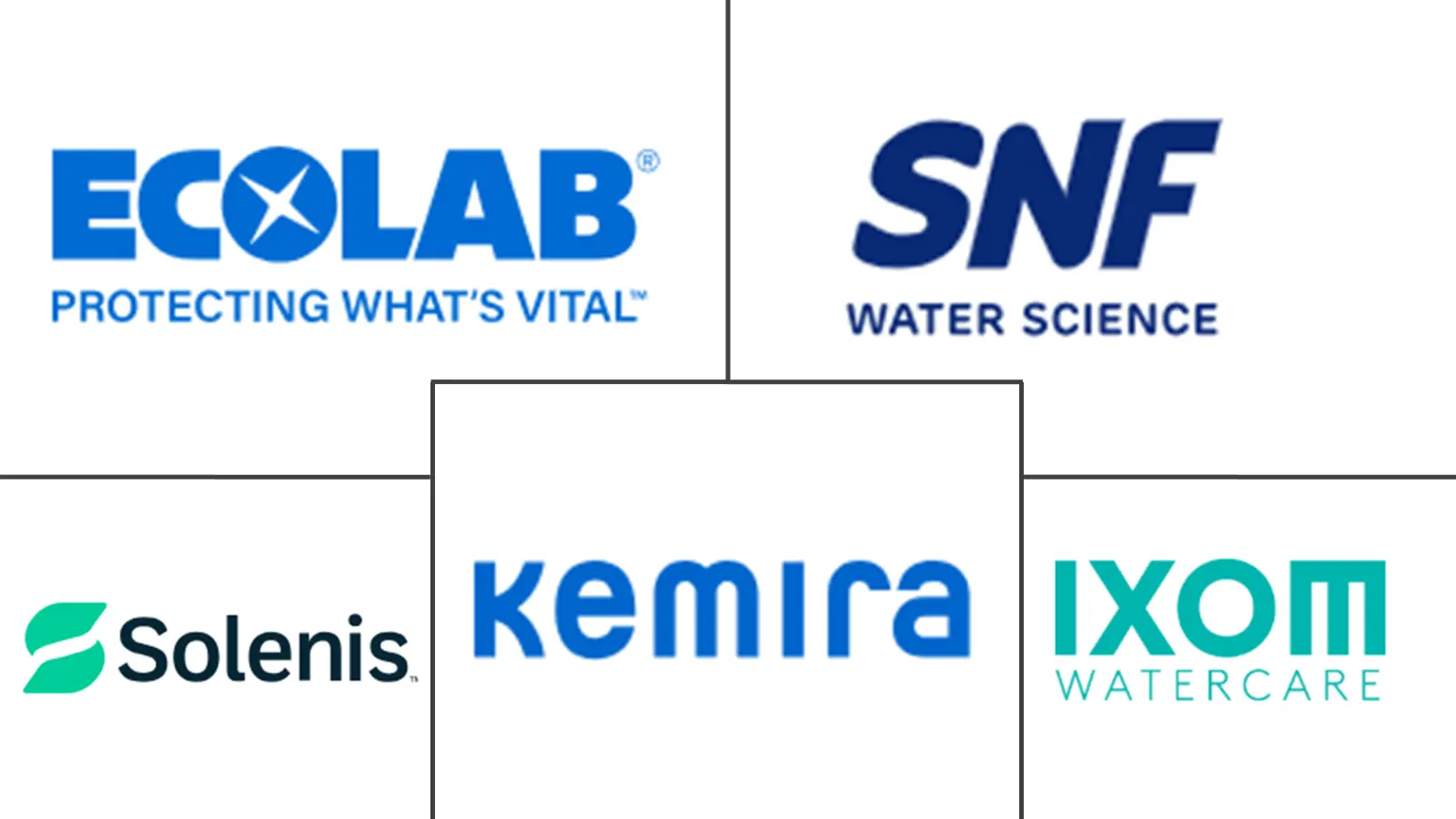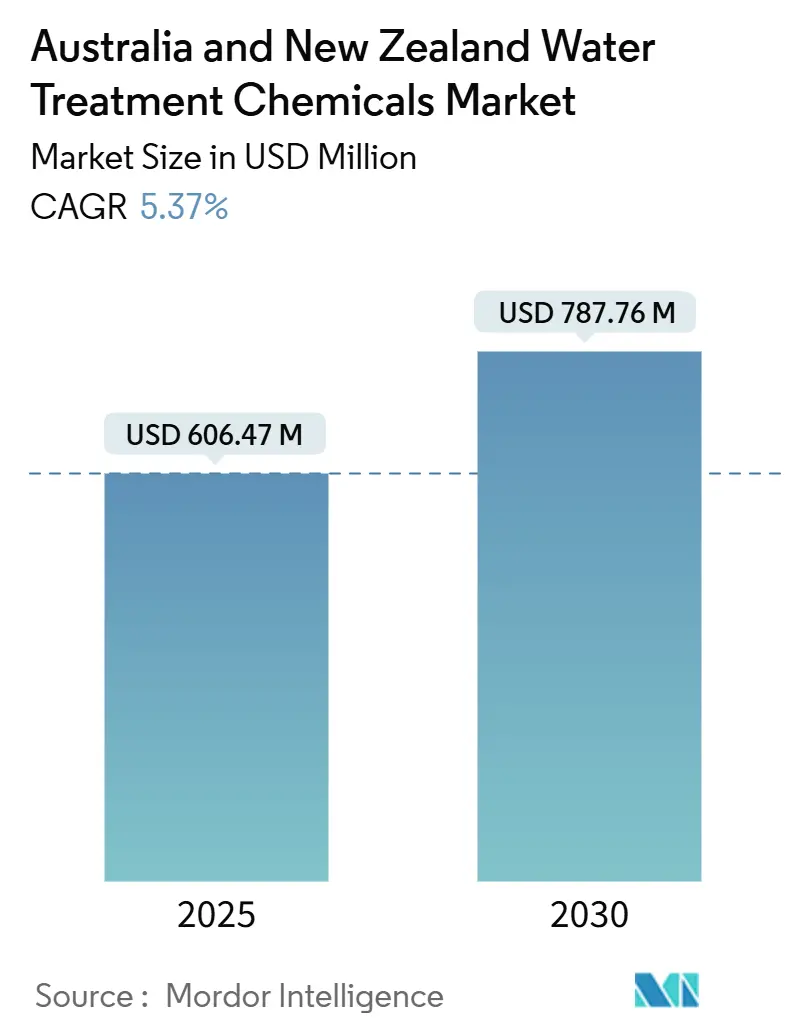
Australia And New Zealand Water Treatment Chemicals Market Analysis by Mordor Intelligence
The Australia and New Zealand water treatment chemicals Market size is estimated at USD 606.47 million in 2025, and is expected to reach USD 787.76 million by 2030, at a CAGR of 5.37% during the forecast period (2025-2030). Growth in the water treatment chemicals market is driven by three synchronized forces: stricter ANZECC 2023 discharge licensing, increasing recycling mandates in mining and power, and the secondary effect of phosphate-free detergents, which lower influent phosphorus yet intensify tertiary nutrient-removal needs. Mining expansions in Western Australia and Queensland, coupled with urban infrastructure renewal in Sydney, Melbourne, and Auckland, are widening opportunities for coagulants, antiscalants, and corrosion inhibitors. Municipal utilities are embedding polyaluminum chloride into retrofits that integrate PFAS removal, while lithium, nickel, and geothermal projects are demanding tailored scale-control programs. Regional supply chains are moderately consolidated, as global majors leverage on-site technical services and digital dosing to deepen account stickiness; however, mid-tier suppliers with proximity advantages remain competitive.
Key Report Takeaways
- In 2024, coagulants and flocculants emerged as the leading product type in the water treatment chemicals market, capturing a 22.66% market share. This segment is projected to grow at a compound annual growth rate (CAGR) of 6.08% during the forecast period, extending through 2030.
- The municipal sector dominated the market by end-user in 2024, accounting for 40.86% of the total market size. This segment is expected to expand at a CAGR of 5.90% through 2030, driven by increasing demand for water treatment solutions in urban areas.
- Geographically, Australia held a commanding 83.30% share of the market revenue in 2024. Meanwhile, New Zealand is forecast to exhibit the highest growth rate, with a CAGR of 5.51% between 2025 and 2030, reflecting its growing focus on water treatment initiatives.
Australia And New Zealand Water Treatment Chemicals Market Trends and Insights
Driver Impact Analysis
| Drivers | (~) % Impact on CAGR Forecast | Geographic Relevance | Impact Timeline |
|---|---|---|---|
| Rising groundwater and surface-water pollution | +1.2% | Australia (Murray-Darling Basin, Great Barrier Reef catchments), New Zealand (Canterbury, Waikato) | Medium term (2-4 years) |
| Growing water-intensive industrial and power demand | +1.5% | Australia (Queensland coal, Western Australia lithium), New Zealand (geothermal Taupo) | Long term (≥ 4 years) |
| Stricter wastewater-discharge licensing under ANZECC 2023 | +1.8% | Australia and New Zealand (national, with early enforcement in NSW, Victoria, and Auckland) | Short term (≤ 2 years) |
| Phosphate-free detergent shift boosts coagulant demand | +0.9% | Australia (urban centers: Sydney, Melbourne, Brisbane), New Zealand (Auckland, Wellington) | Medium term (2-4 years) |
| Rapid adoption of onsite electro-oxidation pretreatment at mines | +0.7% | Australia (remote mine sites in Western Australia, Queensland, Northern Territory) | Medium term (2-4 years) |
| Source: Mordor Intelligence | |||
Rising Groundwater and Surface-Water Pollution
Persistent nutrient loading and emerging contaminants are elevating chemical demand across both nations. In 2024, total phosphorus and chlorophyll-a in the Darling-Baaka River exceeded ANZECC thresholds by factors of 2-3, while Great Barrier Reef catchments saw worsening turbidity despite long-running best-management programs[1]Queensland Government, “Water Quality Audit 2024,” qld.gov.au. PFAS has become a parallel crisis. New South Wales has identified more than 1,100 sites with detectable PFOS and PFOA. The 2025 Australian Drinking Water Guidelines have reduced the combined PFOS+PFHxS limit to 8 ng/L, requiring utilities to pair granular activated carbon and ion-exchange with upstream coagulation to prevent membrane fouling[2]National Health and Medical Research Council, “Australian Drinking Water Guidelines 2025,” nhmrc.gov.au. Canterbury and Waikato aquifers are carrying rising nitrate and E. coli loads, prompting councils to mandate advanced oxidation and biological nutrient removal, both of which increase chemical dosage per megaliter treated. Each new contaminant class heightens formulation complexity and locks utilities into multi-year supply contracts with specialty chemical providers.
Growing Water-Intensive Industrial and Power Demand
Mining and energy capital spending is lifting baseline volumes in the water treatment chemicals market. Australian mining investment reached AUD 53 billion in 2024, with lithium, nickel, and copper projects generating hypersaline effluents that require phosphonate and polyacrylate scale inhibitors to prevent the precipitation of calcium sulfate and silica. Victoria’s hydrogen roadmap projects 118 GL of ultrapure feedwater by 2050, achievable only through ion-exchange polishing and precise pH control. New Zealand geothermal plants in the Taupo Volcanic Zone combat silica scaling with antiscalant and electro-coagulation hybrids, extending maintenance intervals and chemical sales opportunities. As industrial water demand splits between high-volume, low-purity, and low-volume, ultra-high-purity needs, suppliers with diversified portfolios secure a competitive advantage.
Stricter Wastewater-Discharge Licensing Under ANZECC 2023
The 2023 ANZECC update replaces one-size limits with risk-based thresholds for nutrients, metals, and toxicants, adding 1.8 percentage points to the market’s CAGR. New South Wales and Victoria began phased enforcement in 2024, compelling dischargers to install tertiary stages that typically combine biological nutrient removal with ferric or polyaluminum chloride precipitation to meet a total phosphorus limit of < 0.5 mg/L. Auckland’s Watercare is committed to retrofitting all major plants with enhanced coagulation by 2028, which alone will double its annual coagulant consumption. Compressed compliance windows favor vendors with local warehouses and process-optimization staff.
Phosphate-Free Detergent Shift Boosting Coagulant Demand
Retail shifts toward phosphate-free detergents reduce influent phosphorus by up to 47%, yet receiving-water caps have not been relaxed, leaving utilities to close the gap through chemical precipitation. Polyaluminum chloride now dominates because it yields 30% less sludge than alum and remains effective across a pH range of 5.5-8.5, minimizing the need for acid or caustic adjustments. Fonterra disclosed an 18% rise in phosphorus-removal costs in 2024 after shifting plant cleaning agents to phosphate-free blends while maintaining discharge compliance targets. The detergent transition has effectively locked a fresh tranche of long-run demand into the coagulant segment of the water treatment chemicals market.
Restraint Impact Analysis
| Restraints | (~) % Impact on CAGR Forecast | Geographic Relevance | Impact Timeline |
|---|---|---|---|
| Hazard profile and transport restrictions for hydrazine-based oxygen scavengers | -0.6% | Australia (coal and gas power stations in NSW, Queensland, Victoria) | Short term (≤ 2 years) |
| Rising membrane-based and UV alternatives to chemical disinfection | -0.9% | Australia (Sydney, Melbourne, Perth desalination and municipal plants), New Zealand (Auckland, Wellington) | Medium term (2-4 years) |
| Supply-chain exposure to Chinese glyphosate intermediates | -0.5% | Australia and New Zealand (municipal and industrial chemical formulators dependent on imported phosphonate precursors) | Medium term (2-4 years) |
| Source: Mordor Intelligence | |||
Hazard Profile and Transport Restrictions for Hydrazine-Based Oxygen Scavengers
Hydrazine hydrate’s Category 1B carcinogenic label triggers costly placarding, segregation, and driver certification under the Australian Dangerous Goods Code, adding up to 25% to delivered costs for remote power stations. Utilities are switching to carbohydrazide, erythorbate, and DEHA, as exemplified by AGL Energy’s 2024 shift at Loy Yang A, which also resulted in lower insurance premiums. Retirements of coal units by 2030 will further shrink the high-pressure boiler base, which has historically consumed hydrazine, thereby constraining this portion of the water treatment chemicals market.
Rising Membrane-Based and UV Alternatives to Chemical Disinfection
Sydney Water’s 2024 UV expansion treated an additional 150 ML/day without the need for extra chlorine, while Melbourne Water’s Eastern Treatment Plant disinfects 470 ML/day using UV, eliminating trihalomethanes. Although UV modules cost AUD 2-5 million per 10 MLD, they reduce operating costs and bypass dechlorination steps, resulting in a roughly 60% decrease in chemical biocide demand in seawater desalination configurations. Suppliers are mitigating the impact by pivoting toward membrane cleaners and biofilm-control agents that command higher margins than commodity disinfectants.
Segment Analysis
By Product Type: Coagulants Lead Phosphorus-Removal Retrofits
In 2024, coagulants and flocculants captured a 22.66% share of the water treatment chemicals market in Australia and New Zealand, emerging as the leading segment. This category is anticipated to grow at a 6.08% CAGR, surpassing the overall market growth rate. The municipal sector is a key driver, with facilities upgrading their processes to use polyaluminum chloride and ferric chloride, achieving effluent phosphorus levels below 0.5 mg/L. Meanwhile, the mining industry is contributing additional demand by employing high-molecular-weight polyacrylamide flocculants for tailings-water clarification, facilitating the efficient settling of fines in iron-ore, lithium, and copper processing circuits.
Secondary chemical classes grow at differentiated rates. Biocides and disinfectants face headwinds from the adoption of membranes, yet remain entrenched for controlling distribution residuals and cooling-tower biofilm. Scale inhibitors expand alongside desalination growth, with Perth’s new Alkimos plant consuming phosphonate doses to prevent calcium sulfate scaling in 55% recovery RO trains. Corrosion inhibitors occupy niche but high-margin roles in geothermal condensate loops and food-grade systems. AS/NZS 4020 certification maintains a high compliance barrier that entrenches incumbent suppliers.
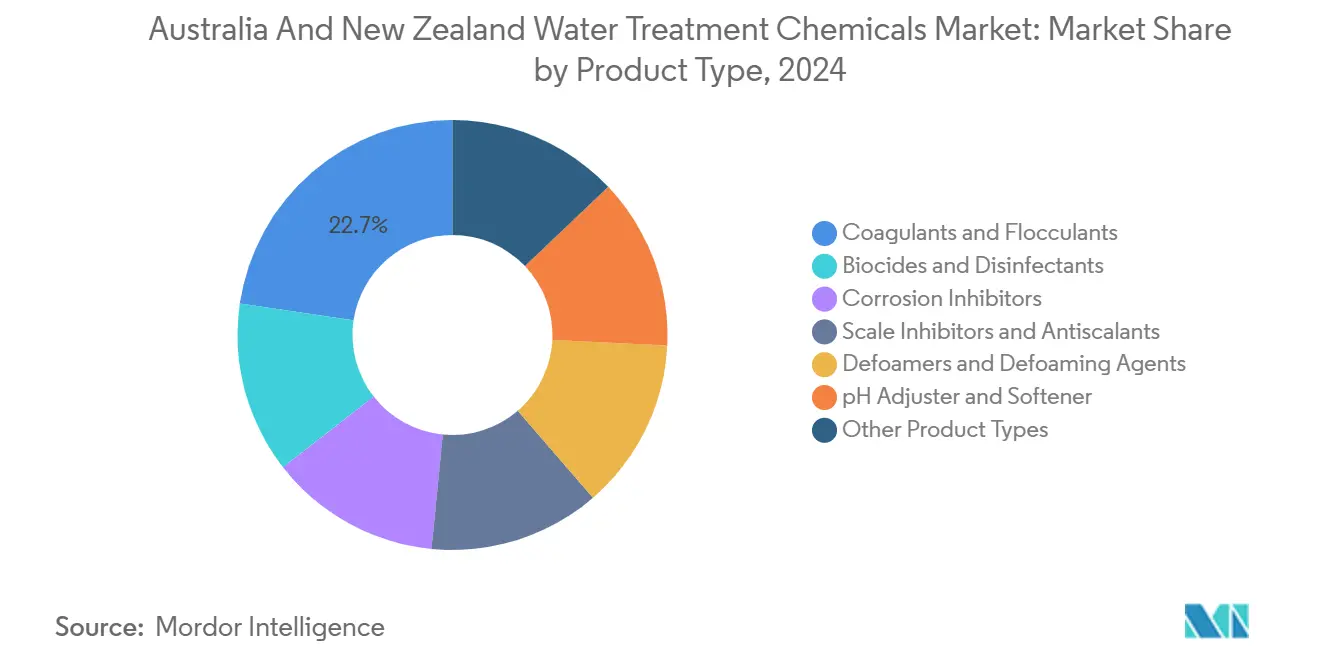
Note: Segment shares of all individual segments available upon report purchase
By End-User Industry: Municipal Dominance Anchored in Regulatory Compliance
In 2024, municipal utilities represented 40.86% of the water treatment chemicals market value. This sub-segment is projected to grow at a CAGR of 5.90% through 2030, driven by key factors such as PFAS removal, advancements in tertiary nutrient polishing, and increased desalination capacity. The rising chemical intensity per treated megaliter, attributed to the addition of more unit processes compared to 2015, reflects evolving operational demands. Despite stable per-capita demand resulting from drought management, Sydney Water reported a 12% increase in chemical expenditure for FY 2024, highlighting the growing reliance on chemical solutions in water treatment.
Mining and mineral processing ranks second, underpinned by Western Australia’s lithium boom and Queensland’s copper push. Rio Tinto’s Gudai-Darri mine now recycles 80% of process water using tailored flocculant programs. Power generation demand is shifting as coal units phase out and mothball their boilers, while new gas and geothermal plants exhibit lower chemical intensity per megawatt-hour (MWh). The food and beverage industry, particularly New Zealand’s dairy sector, utilizes substantial quantities of caustic, acidic, and nutrient-rich blends. Fonterra’s 2024 disclosures indicate a 9% increase in chemical costs, attributed to the addition of new processing lines.
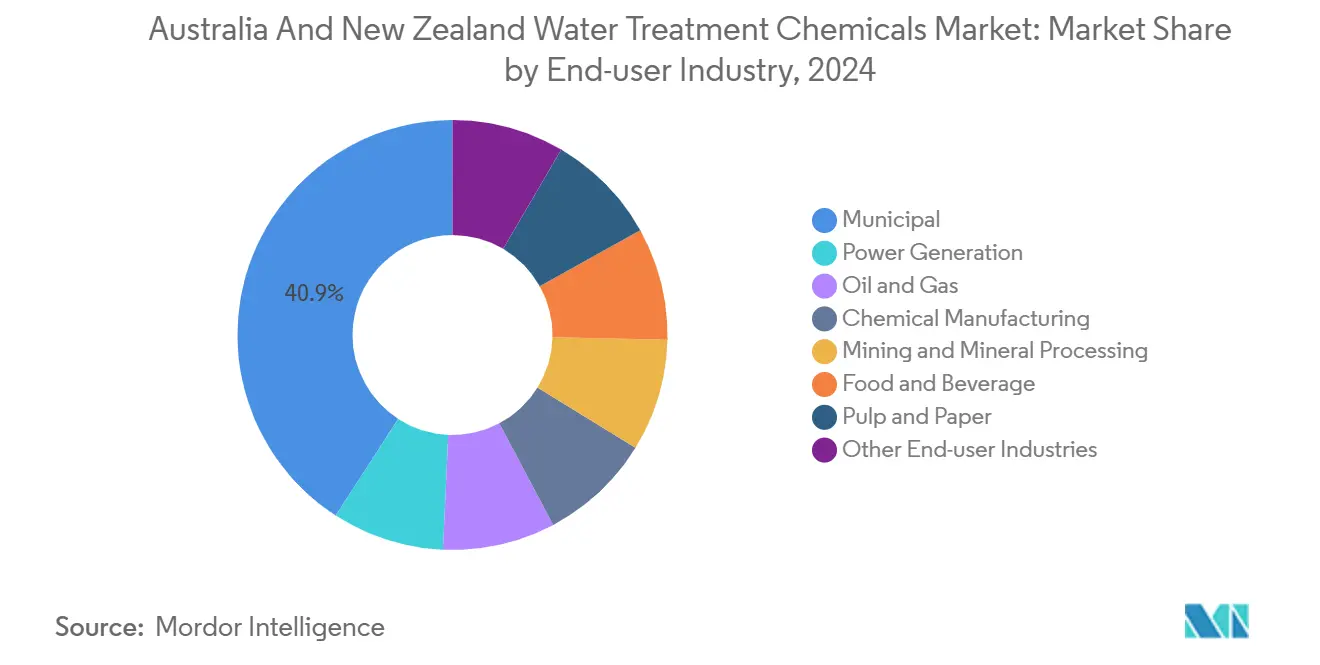
Note: Segment shares of all individual segments available upon report purchase
Geography Analysis
Australia commanded 83.30% of the 2024 regional revenue in the water treatment chemicals market, driven by a population of 26 million, a water-stressed climate, and high resource-extraction intensity. Western Australia, Queensland, and the Northern Territory contribute the fastest growth as lithium and copper miners adopt closed-loop water systems to secure licenses under tightened groundwater caps. Major urban utilities in Sydney, Melbourne, Brisbane, and Perth collectively drive significant, recurring demand for coagulants, antiscalants, and disinfectants, especially as desalination helps offset rainfall variability in Perth and Adelaide.
New Zealand’s water treatment chemicals market is projected to post a faster 5.51% CAGR from a smaller base, driven by the need for dairy sector wastewater control and the expansion of geothermal power. Dairy wastewater loads in Canterbury, Waikato, and Taranaki equal the effluent volume of a city with a population of 35 million and now face stricter nitrogen consent requirements, stimulating sales of polymer flocculants and pH adjusters. Geothermal stations in the Taupo Volcanic Zone utilize antiscalant and electrocoagulation hybrids to mitigate silica deposition, thereby extending the life of chemicals as capacity increases. Auckland’s population surge past 2 million by 2030 is forcing Watercare to scale drinking- and wastewater treatment footprints, adding double-digit growth for coagulants and disinfectants.
Regulatory divergence shapes supplier strategies. Australia’s state-based EPAs impose varied PFAS and salinity limits, which complicates national tenders, whereas New Zealand’s unitary framework still leaves regional councils discretion in setting nutrient caps. Both systems are converging on ecological-risk approaches, rewarding vendors that pair dosing equipment with modeling capabilities to meet site-specific endpoints, rather than relying on legacy blanket standards.
Competitive Landscape
The water treatment chemicals market in Australia and New Zealand is moderately consolidated, characterized by continuous product innovation and technological advancements. Leading companies focus on developing environmentally sustainable solutions and automated dosing systems. Companies are increasingly investing in digitalization and cloud-based monitoring solutions to provide comprehensive water management services to end-users. The emphasis on research and development, coupled with the introduction of new technologies for water purification chemicals, demonstrates the industry's commitment to addressing evolving customer needs and environmental regulations.
Australia And New Zealand Water Treatment Chemicals Industry Leaders
-
Ecolab
-
Kemira Oyj
-
Solenis
-
SNF
-
Ixom
- *Disclaimer: Major Players sorted in no particular order
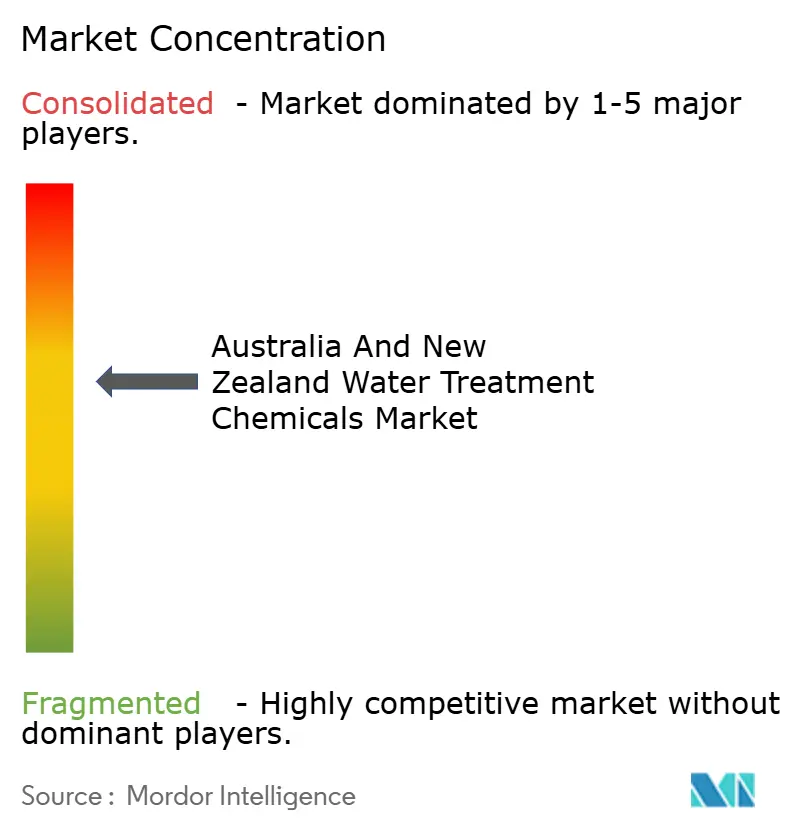
Recent Industry Developments
- March 2025: Ecolab invested AUD 15 million to expand its Melbourne hub, adding specialty coagulant and corrosion-inhibitor lines coupled with a regional digital water-management center.
- February 2025: Watercare awarded Kemira a five-year NZD 80 million supply contract for polyaluminum chloride and polymers at Mangere and Rosedale upgrades.
- January 2025: Ixom completed the acquisition of a specialty chemicals distributor in Queensland, expanding its footprint in coal-seam-gas produced-water treatment and adding formulation capabilities for high-salinity applications.
Australia And New Zealand Water Treatment Chemicals Market Report Scope
Water treatment is a process that extracts or reduces the level of pollutants and undesirable components from water to make it suitable for use. The chemicals used in this method are referred to as water treatment chemicals.
The Australia and New Zealand water treatment chemicals market is segmented by product type and end-user industry. By product type market is segmented into biocides and disinfectants, coagulants and flocculants, corrosion inhibitors, scale inhibitors and antiscalants, defoamers and defoaming agents, pH adjusters and softeners, and other product types. By end-user industry, the market is segmented into power generation, oil and gas, chemical manufacturing, mining and mineral processing, municipal, food and beverage, pulp and paper, and other end-user industries. The report's geographical coverage includes Australia and New Zealand. The report provides the market size and forecasts in terms of revenue (USD) for all the above segments.
| Biocides and Disinfectants |
| Coagulants and Flocculants |
| Corrosion Inhibitors |
| Scale Inhibitors and Antiscalants |
| Defoamers and Defoaming Agents |
| pH Adjuster and Softener |
| Other Product Types |
| Power Generation |
| Oil and Gas |
| Chemical Manufacturing |
| Mining and Mineral Processing |
| Municipal |
| Food and Beverage |
| Pulp and Paper |
| Other End-user Industries |
| Australia |
| New Zealand |
| By Product Type | Biocides and Disinfectants |
| Coagulants and Flocculants | |
| Corrosion Inhibitors | |
| Scale Inhibitors and Antiscalants | |
| Defoamers and Defoaming Agents | |
| pH Adjuster and Softener | |
| Other Product Types | |
| By End-user Industry | Power Generation |
| Oil and Gas | |
| Chemical Manufacturing | |
| Mining and Mineral Processing | |
| Municipal | |
| Food and Beverage | |
| Pulp and Paper | |
| Other End-user Industries | |
| By Geography | Australia |
| New Zealand |
Key Questions Answered in the Report
What is the projected value of the Australia and New Zealand water treatment chemicals market in 2030?
It is forecast to reach USD 787.76 million by 2030.
Which product category is growing the fastest?
Coagulants and flocculants are expanding at a 6.08% CAGR through 2030 due to phosphorus-removal retrofits.
Why is municipal demand rising despite stable per-capita water use?
Utilities must add PFAS, nutrient-polishing, and desalination steps, each of which increases chemical intensity per megaliter.
How are regulatory changes affecting suppliers?
ANZECC 2023 risk-based limits and regional nutrient caps require advanced treatment, favoring firms with local service and modeling capabilities.
What key sustainability trend is reshaping product portfolios?
Bio-based coagulants and AI-optimized dosing systems are gaining traction as utilities strive to achieve carbon and sludge reduction goals.
Page last updated on:
